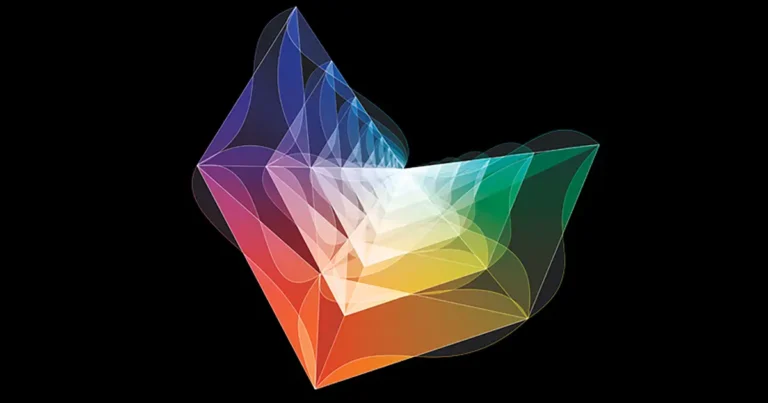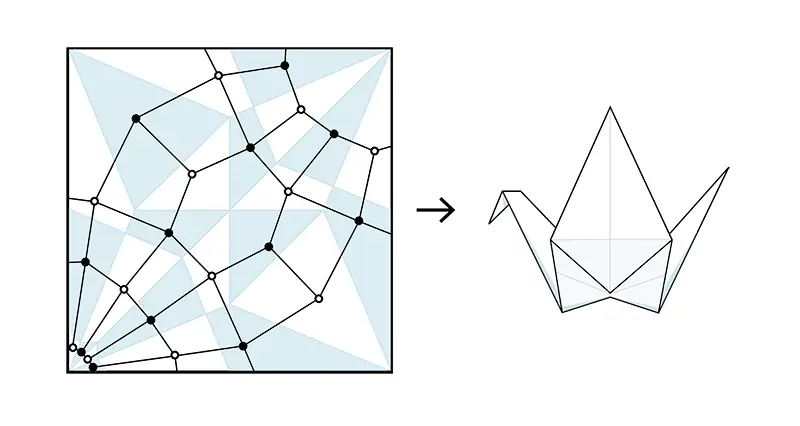The Folded Universe: Origami & Particle Physics Combined
A decades-old physics puzzle about how particles interact has been solved using the mathematical rules of paper folding, revealing a hidden connection between the quantum world and the ancient art.

Key Findings
- The rules for folding a piece of paper flat are mathematically identical to the geometric laws governing particle collisions.
- This discovery proves a decade-old idea called the BCFW triangulation conjecture for the momentum amplituhedron.
- The amplituhedron, a geometric object representing particle interactions, can now be simply defined as all conditions that allow a valid origami fold.
- This work solidifies a new, simpler geometric approach to physics, aiming to replace the complex Feynman diagrams.
- The connection also solved open problems in other fields of science, like statistical mechanics.
Primary Source
Source: Amplituhedra and origami
Author(s): Pavel Galashin
What does a folded paper crane have to do with a high-energy particle collision? One is a quiet, careful art. The other is one of the most violent events in the universe. For years, scientists thought they were worlds apart. But a stunning new discovery shows they are almost the same thing. It turns out the universe uses the same deep mathematical rules for both.
What is this Surprising Connection?
The new finding is a perfect, one-to-one match. A mathematician named Pavel Galashin proved it in October 2024.1Hartnett, Kevin. “Origami Patterns Solve a Major Physics Riddle.” Quanta Magazine, accessed October 15, 2025, https://www.quantamagazine.org/origami-patterns-solve-a-major-physics-riddle-20251006/ He showed that for every possible particle collision, there is one unique origami crease pattern that describes it. This is not just a neat coincidence. It is a deep truth that solved a huge puzzle in modern physics. The discovery validates a whole new way of looking at the universe. It suggests the laws of reality are not just in complex equations. They are also in the simple, elegant folds of a piece of paper.
How Can We Calculate a Particle Collision?
For a long time, physicists used a tool called Feynman diagrams. These diagrams helped them predict what happens when tiny particles smash together. But this method was very messy. A single collision could require calculating thousands or even millions of diagrams.2Origami Patterns Solve a Major Physics Riddle | Quanta Magazine, accessed October 15, 2025, https://www.quantamagazine.org/origami-patterns-solve-a-major-physics-riddle-20251006/ The final answer was often very simple. But the process to get there was a nightmare. Scientists knew there had to be a better way.
Then, in 2013, a group of physicists proposed a revolutionary idea.3The Amplituhedron: Structure, Combinatorics, and Positive Geometry – Indico Global, accessed October 15, 2025, https://indico.global/event/9646/attachments/60294/116508/Amplituhedron%202025%20abstracts%20(2).pdf They imagined a beautiful geometric shape called the amplituhedron. They claimed the volume of this single shape was the answer. Calculating the volume of one object could replace the millions of messy diagrams. This was a huge leap forward. But there was a problem. They needed to prove that their new geometric method gave the correct answers every single time. And for the most important version of the problem, the proof was missing for over ten years.
How Does Origami Solve the Problem?
This is where Pavel Galashin’s work comes in. He built a bridge between the world of physics and the world of origami. He showed that the information from a particle collision could be used to define a piece of paper. The properties of the particles defined the paper’s shape. He then proved that there is only one way to draw creases on that paper so it can fold flat.4abstracts, accessed October 15, 2025, https://pi.math.cornell.edu/~webgeo/F24abstracts/galashin.html

The diagram shows this direct translation in action. The light blue shapes are the creases needed to fold a paper crane. Overlaid on top is the plabic graph, the mathematical map physicists use. Each black or white dot represents a flat face on the folded paper, and the lines connecting them are the creases themselves. The breakthrough is realizing this is a perfect match; the rules for a valid physics graph are the exact same rules that allow the paper to fold flat.
This unique origami pattern holds the answer. It can be translated into a piece of the amplituhedron. Because the pattern is always unique, it proves the geometric pieces of the amplituhedron fit together perfectly, leaving no gaps and having no overlaps.
Why Does This Discovery Matter?
This discovery is a huge victory for the new geometric approach to physics. It gives scientists confidence that they are on the right path. A path away from messy calculations and toward a simple, elegant picture of the universe. This connection is also a two-way street. The work not only solved a physics riddle but also solved long-standing puzzles in other fields like mathematics and statistical mechanics.5Amplituhedra and origami, accessed October 15, 2025, https://arxiv.org/pdf/2410.09574 It shows that different areas of science are more deeply connected than we ever knew.
What Happens Next?
There is still more work to do. This proof confirms that cutting the amplituhedron into pieces is a valid way to get the right answer. But the ultimate goal is even bigger. Physicists want to find a way to calculate the volume of the whole amplituhedron at once. That would be the final step in this quest for simplicity. This origami connection gives them a powerful new set of tools to try and achieve that goal. It asks a profound question. Why does this connection exist at all? The answer may lead to an even deeper understanding of our reality.
